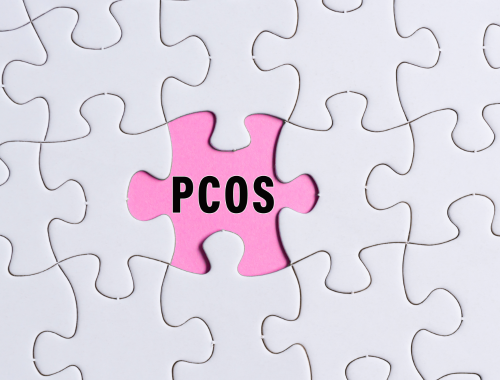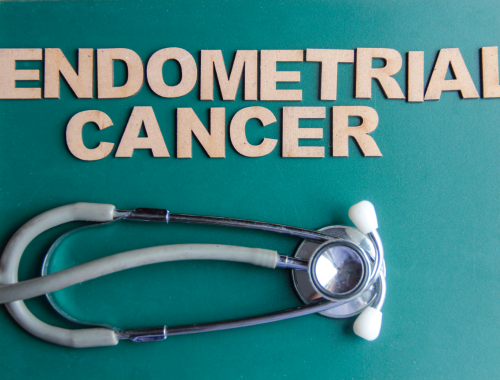Difference Between Polycystic Ovary Syndrome PCOS and Endometrial Cancer
Polycystic ovary syndrome (PCOS), as its name suggests, is a gynecological condition that is characterized by the presence of multiple cysts in the ovaries. The syndrome occurs due to a hormonal imbalance in the female body and manifests as infertility, irregular menses, excess hair growth, and acne. Endometrial cancer is the carcinoma of the innermost layer of the uterus which is the endometrium.

What is Polycystic ovary syndrome (PCOS)?
Definition:
Polycystic ovary syndrome (PCOS), as its name suggests, is a gynecological condition that is characterized by the presence of multiple cysts in the ovaries.
Symptoms:
The common symptoms of PCOS include obesity, irregular menstrual cycle, excess hair growth in females (hirsutism), dark patches of skin (acanthosis nigricans), balding, and infertility.
Causes:
Excess of male sex hormones called androgens is the primary cause of PCOS. Other than hyperandrogenism, insulin resistance, and low-grade inflammation also leads to PCOS.
Diagnosis:
Medical history and physical examination are key to diagnosing PCOS. A physical examination will reveal obesity, hirsutism, acanthosis nigricans, and skin hyperpigmentation in PCOS patients. It is important to know that the most important investigation for diagnosis of PCOS is pelvic ultrasound and hormone levels. A pelvic ultrasound will show multiple cysts in the ovaries.
Treatment:
Treatment choices for PCOS include weight reduction, hormonal contraceptives like combined oral pills, intrauterine devices to control heavy menstrual bleeding, metformin to tackle insulin resistance, and antiandrogen medications.

What is endometrial cancer?
Definition:
Endometrial cancer is the carcinoma of the innermost layer of the uterus which is the endometrium.
Symptoms:
Endometrial cancer occurs usually after menopause. The common symptoms of endometrial cancer are intermenstrual bleeding (bleeding between two periods), postmenopausal bleeding, pelvic pain, vaginal discharge, and heavy vaginal bleeding after 40 years of age.
Risk factors:
Early menarche, late menopause, nulliparity, use of estrogen therapy, tamoxifen use, and obesity are some of the risk factors for endometrial cancer.
Diagnosis:
History and physical examination provide clues to diagnose endometrial cancer. The best tests however are transvaginal ultrasound scans to determine the endometrial thickness as well as subsequent hysteroscopy and biopsy.
Treatment:
Endometrial cancer is treated mainly with surgery. The surgical options are total hysterectomy, bilateral salpingo-oophorectomy, and pelvic and para-aortic lymphadenectomy.
Difference between Polycystic ovary syndrome (PCOS) and Endometrial cancer
Definition:
Polycystic ovary syndrome (PCOS), as its name suggests, is a gynecological condition that is characterized by the presence of multiple cysts in the ovaries. Endometrial cancer is the carcinoma of the innermost layer of the uterus which is the endometrium.
Symptoms:
The common symptoms of PCOS include obesity, irregular menstrual cycle, excess hair growth in females (hirsutism), dark patches of skin (acanthosis nigricans), balding, and infertility. The common symptoms of endometrial cancer are intermenstrual bleeding (bleeding between two periods), postmenopausal bleeding, pelvic pain, vaginal discharge, and heavy vaginal bleeding after 40 years of age.
Causes/ Risk factors:
Excess of male sex hormones called androgens is the primary cause of PCOS. Other than hyperandrogenism, insulin resistance, and low-grade inflammation also leads to PCOS. Early menarche, late menopause, nulliparity, use of estrogen therapy, tamoxifen use, and obesity are some of the risk factors for endometrial cancer.
Diagnosis:
Medical history and physical examination are key to diagnosing PCOS. A physical examination will reveal obesity, hirsutism, acanthosis nigricans, and skin hyperpigmentation in PCOS patients. It is important to know that the most important investigation for diagnosis of PCOS is pelvic ultrasound and hormone levels. A pelvic ultrasound will show multiple cysts in the ovaries.
History and physical examination provide clues to diagnose endometrial cancer. The best tests however are transvaginal ultrasound scans to determine the endometrial thickness as well as subsequent hysteroscopy and biopsy.
Treatment:
Treatment choices for PCOS include weight reduction, hormonal contraceptives like combined oral pills, intrauterine devices to control heavy menstrual bleeding, metformin to tackle insulin resistance, and antiandrogen medications. Endometrial cancer is treated mainly with surgery. The surgical options are total hysterectomy, bilateral salpingo-oophorectomy, and pelvic and para-aortic lymphadenectomy.
Table of differences between Polycystic ovary syndrome (PCOS) and Endometrial cancer

FAQs
Are there any risk factors for developing Polycystic ovary syndrome (PCOS) or Endometrial cancer?
Risk factors for developing PCOS are obesity, hyperandrogenism, insulin resistance, and low-grade inflammation. Early menarche, late menopause, nulliparity, use of estrogen therapy, tamoxifen use, and obesity are some of the risk factors for endometrial cancer.
How are Polycystic ovary syndrome (PCOS) and Endometrial cancer treated differently?
PCOS is treated mainly with weight reduction and medications while endometrial cancer is treated with surgery.
Can Polycystic ovary syndrome (PCOS) lead to Endometrial cancer?
Yes.
What are the long-term consequences of Polycystic ovary syndrome (PCOS) and Endometrial cancer?
Long-term consequences of PCOS include the development of hypertension, type 2, infertility, and endometrial carcinoma. Long-term consequences of endometrial carcinoma are depression and infertility.
Can lifestyle changes help prevent or manage Polycystic ovary syndrome (PCOS) and Endometrial cancer?
The key to reducing PCOS symptoms is weight reduction. A healthy body mass index can help prevent PCOS. There is evidence of reduced endometrial cancer risk in physically active people.
Are there any screening tests available for Polycystic ovary syndrome (PCOS) or Endometrial cancer?
Screening test for PCOS and endometrial cancer is primarily pelvic ultrasound.
Is there a connection between Polycystic ovary syndrome (PCOS) and Endometrial cancer?
Yes, PCOS can lead to endometrial cancer.
Can Endometrial cancer be caused by hormonal imbalances associated with PCOS?
Yes, high levels of unopposed estrogen in PCOS can lead to endometrial cancer.
Can Polycystic ovary syndrome (PCOS) or Endometrial cancer affect fertility?
Both these conditions lead to subfertility.
How are Polycystic ovary syndrome (PCOS) and Endometrial cancer monitored and managed over time?
The conditions are monitored via blood tests which measure estrogen, androgens, and follicle-stimulating hormone.
Can hormone therapy be used to treat Polycystic ovary syndrome (PCOS) or Endometrial cancer?
Yes.
What is the outlook for someone with Polycystic ovary syndrome (PCOS) or Endometrial cancer?
Having these conditions results in a toll on mental health and a negative outlook on life as the conditions are chronic.
Are there any lifestyle changes or dietary recommendations that can help manage or prevent Polycystic ovary syndrome (PCOS) or Endometrial cancer?
Weight reduction, low carbohydrate, and high protein diet.
Can other health conditions or factors impact the development of Polycystic ovary syndrome (PCOS) or Endometrial cancer?
Yes, having diabetes, hypertension, obesity, using tamoxifen for breast cancer and smoking can lead to these conditions
- Differences Between Reptiles and Amphibians - May 17, 2024
- Difference Between Ophthalmology and Optometry - May 15, 2024
- Difference Between Fear and Anxiety - April 2, 2024
Search DifferenceBetween.net :
Leave a Response
References :
[0]Azziz, Ricardo. "PCOS: a diagnostic challenge." Reproductive biomedicine online 8.6 (2004): 644-648.
[1]Haoula, Zeina, Maisa Salman, and William Atiomo. "Evaluating the association between endometrial cancer and polycystic ovary syndrome." Human reproduction 27.5 (2012): 1327-1331.
[2]Dumesic, Daniel A., and Rogerio A. Lobo. "Cancer risk and PCOS." Steroids 78.8 (2013): 782-785.
